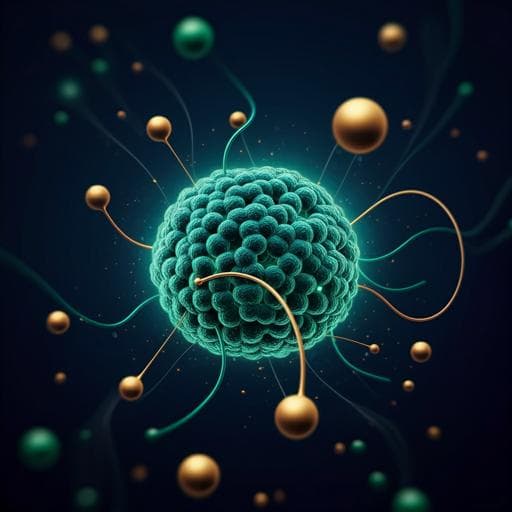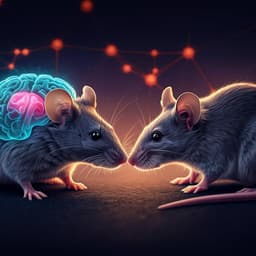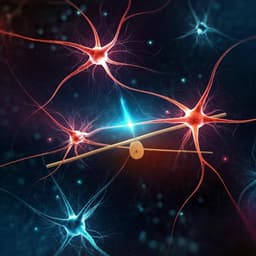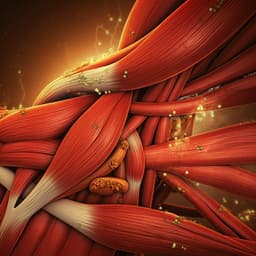
Medicine and Health
Astrocytic neuroligin 3 regulates social memory and synaptic plasticity through adenosine signaling in male mice
R. Dang, A. Liu, et al.
Discover groundbreaking insights into social memory impairment and its connection to brain disorders, as researchers Rui Dang, An Liu, Yu Zhou, and colleagues reveal how astrocytic deletion of NLG3 affects astrocyte function and social memory in mice. This study uncovers potential therapeutic strategies targeting glutamate transporters and adenosine signaling pathways.
~3 min • Beginner • English
Introduction
Social recognition memory is fundamental for appropriate social behaviors and is disrupted in disorders such as autism and schizophrenia. Hippocampal circuits, including dorsal CA2, ventral CA1, and dentate gyrus, are implicated in social memory, yet the contributions of non-neuronal cells remain poorly defined. Astrocytes, which enwrap synapses and modulate synaptogenesis, ion homeostasis, transmission, and plasticity, have been linked to several memory forms, but their role in social memory is unclear. Neuroligins (NLGs), especially NLG3, are synaptic adhesion proteins associated with neurodevelopmental and psychiatric conditions. While neuronal NLG functions are well studied, astrocytic NLGs are less understood beyond developmental morphogenesis and synapse formation. The study tests the hypothesis that astrocytic NLG3 in adult ventral hippocampus regulates social memory by controlling astrocyte activity, glutamate homeostasis, and synaptic plasticity via adenosine signaling.
Literature Review
Prior work established the hippocampus, particularly CA2 and ventral CA1, as critical for social memory storage in rodents, with support from human and primate studies. Astrocytes exhibit activity-dependent Ca2+ responses and release gliotransmitters (glutamate, ATP/adenosine, D-serine) that modulate synaptic plasticity and memory. D-serine from astrocytes facilitates NMDA receptor function and LTP; adenosine regulates plasticity and behavior via A1/A2a receptors, although receptor-specific roles can be complex and context-dependent. Neuroligins are essential for synapse maturation; astrocytic NLGs have been shown to regulate astrocyte morphogenesis and synapse development, but their functions at mature synapses and in memory remained unknown. EAAT2 (GLT-1) is the predominant astrocytic glutamate transporter critical for glutamate clearance, influencing synaptic plasticity, with overexpression known to impair LTP and memory. Adenosine signaling in hippocampal plasticity is nuanced: pharmacology suggests A1 receptors generally suppress and A2a receptors facilitate plasticity, but genetic models show region- and cell type-specific effects. These studies set the stage for investigating astrocytic NLG3 in social memory mechanisms.
Methodology
- Genetic models: Generated inducible astrocyte-specific NLG3 knockout by crossing NLG3 floxed (NLG3fl/fl) mice with hGFAP-CreERT2; tamoxifen (1 mg i.p. daily for 7 days) at >P60 induced recombination (GFAP-NLG3 KO). Global NLG3 KO mice used for comparison. Specific hippocampal astrocyte deletion achieved via AAV-GFAP-EGFP-T2A-Cre injections into dorsal/ventral hippocampus of NLG3fl/fl adults. Neuronal NLG3 deletion used CaMKIIα-EGFP-T2A-Cre AAV. For rescue, Cre-dependent CMV-DIO-NLG3-HA was co-injected with GFAP-Cre AAV. Neuronal A2a receptor deletion used AAV CaMKIIα-EGFP-T2A-Cre in A2afl/fl mice.
- Validation: Western blots confirmed NLG3 reduction post-tamoxifen or post AAV-Cre; Ai9 reporter crosses validated hGFAP-CreERT2 specificity to GFAP+ cells; GFAP/mCherry co-localization showed astrocyte-specific targeting; DCX staining indicated no targeting of adult-born neurons by GFAP virus.
- Behavior: Three-chamber sociability and social novelty tests (10-min stages for habituation, sociability, recognition); open field; elevated plus maze; buried food and social odor habituation/dishabituation; novel object recognition; contextual fear memory. Chemogenetics: AAV EF1α-DIO-hM3D(Gq)-mCherry or DIO-mCherry in ventral hippocampus of NLG3+/−;hGFAP-CreERT2, tamoxifen as above; CNO 0.5 mg/kg i.p. 20 min before testing. Pharmacology: Local bilateral ventral hippocampal injections via cannula—TFB-TBOA (EAAT1/2 inhibitor, 50 nM, 1 µl/side, 30 min before test), SCH 58261 (A2a antagonist, 100 nM, 1 µl/side); systemic CGS 21680 (A2a agonist) 0.5 mg/kg i.p. 20 min prior.
- Calcium imaging ex vivo: rAAV2/5-GfaABC1D-cyto-GCaMP6f + DIO-mCherry co-injected into ventral hippocampus of hGFAP-CreERT2 or NLG3;hGFAP-CreERT2; tamoxifen; acute hippocampal slices imaged by confocal. HFS protocol: 100 Hz, 1 s; pharmacology included PPADS 50 µM + suramin 100 µM, MCPG 100 µM, AP5 50 µM. Glutamate perfusion (10 µM) used to test receptor responsiveness. Neuronal Ca2+ imaging used rAAV2/9-CaMKII-cyto-GCaMP6f. hM3D(Gq) activation in slices used CNO 5 µM.
- Fiber photometry in vivo: Optic fibers implanted above ventral CA1 following injections of GfaABC1D-GCaMP6f (astrocyte Ca2+), GfaABC1D-iGluSnFR (glutamate), or CaMKII-GRABAdo (adenosine). Recordings during exploration of empty wire cage and during social sniffing of a stranger mouse. ΔF/F0 analyzed around sniffing epochs.
- Biochemistry and histology: Western blots for NLG1/2/3, EAAT1/2/3, Kir4.1, P2X, P2Y1, mGluR5, p-mTOR, PKA/p-PKA; immunostaining for EAAT2 (total, surface), GFAP, S100β, NeuN, DCX; qPCR for EAAT1/2/3 mRNAs. mTOR inhibitor 1 (10 µM, 3 h) on acute slices tested translational regulation of EAAT2.
- Extracellular adenosine: Microdialysis in ventral hippocampus (probe with 50 kDa cutoff) in freely moving mice during 10 min social interaction; adenosine measured with enzymatic assay; EHNA included to inhibit adenosine deaminase. GRABAdo photometry validated adenosine transients.
- Electrophysiology: Field fEPSPs recorded at SC-CA1 in ventral hippocampus; input-output curves; paired-pulse facilitation (25–1000 ms); LTP induced by 4 trains of 100 Hz, 1 s, 10 s inter-train. Pharmacological rescue tests: adenosine 400 nM, D-serine 400 nM, CGS 21680 30 nM, CPA 500 nM, ATP 400 nM, bzATP 400 nM, ATPγS 400 nM, SCH 58261 100 nM, TFB-TBOA 50 or 150 nM. Whole-cell recordings for mEPSCs and AMPAR/NMDAR ratio. PTP and during-train fEPSP summation analyzed.
- Morphology/physiology of astrocytes: Counts (GFAP/S100β), Sholl-based morphology, EM ultrastructure of excitatory synapses, whole-cell astrocyte electrophysiology (RMP, input resistance, currents, Kir4.1).
- Statistics: t tests (paired/unpaired), one-way and two-way ANOVA with appropriate multiple comparison corrections; data reported as mean ± SEM with n for cells/slices/mice as specified.
Key Findings
- Behavioral specificity: Astrocytic NLG3 deletion (GFAP-NLG3 KO) did not alter locomotion or anxiety (open field, elevated plus maze), sociability (stage 2), novel object recognition, olfaction, or short-term contextual fear, but impaired social recognition memory (stage 3). Global NLG3 KO showed broader phenotypes (hyperactivity, olfactory deficits), highlighting astrocyte-specific effects on social memory.
- Regional requirement: Astrocyte-specific NLG3 deletion restricted to ventral hippocampus impaired social memory (WT+GFAP-Cre S2>S1 p=0.004; NLG3Δ/Δ no preference, memory index p=0.0151); deletion restricted to dorsal hippocampus did not impair social memory. Re-expression of NLG3-HA in ventral hippocampal astrocytes of GFAP-NLG3 KO rescued social memory (stage 3 sniffing p=0.002; memory index p=0.0106).
- Astrocyte activity: HFS-evoked astrocytic Ca2+ transients present in controls (p=0.00203) but absent in GFAP-NLG3 KO; fraction of activated astrocytes reduced (p=2.08×10^-6). HFS-induced Ca2+ responses blocked by PPADS+suramin and MCPG, not by AP5. In vivo, social sniffing increased astrocytic GCaMP6f signals in WT (p<0.001), not in KO.
- Chemogenetic rescue: Activating astrocytes with hM3D(Gq) increased Ca2+ in slices (CNO vs DMSO p=0.0113) and increased fraction of activated astrocytes (p=3.84×10^-8); improved social memory in GFAP-NLG3 KO (stage 3 sniffing p=0.010; memory index p=0.0199).
- EAAT2 upregulation: EAAT2 protein increased in GFAP-NLG3 KO (WB p=0.0494); immunofluorescence increased in total hippocampus (p=0.00754) and GFAP+ astrocytes (p=4.53×10^-5); surface EAAT2 elevated (total p=0.0260; GFAP+ cells p=8.71×10^-6). Re-expression of NLG3 reduced EAAT2 (p=0.0265). EAAT1 protein increased by WB but not IF; EAAT3 unchanged. EAAT2 mRNA decreased, while p-mTOR increased and mTOR inhibitor normalized EAAT2, indicating mTOR-dependent translational upregulation.
- Extracellular glutamate reduced: In vivo iGluSnFR signals during social sniffing increased in WT but not KO; reduction in KO significant after initial sniffing (p=0.0437). Exogenous glutamate (10 µM) elicited comparable astrocytic Ca2+ in WT and KO, indicating receptor integrity. EAAT inhibition with TFB-TBOA (50 nM) restored HFS-evoked astrocytic Ca2+ in KO to WT levels; local TFB-TBOA injections rescued social memory in KO (stage 3 sniffing and memory index p<0.001).
- Synaptic plasticity: Basal synaptic transmission and PPF normal. LTP (4×100 Hz) abolished in GFAP-NLG3 KO (p=2.49×10^-6) and in hippocampus-specific astrocytic NLG3 deletion; also impaired in dorsal hippocampal slices. TFB-TBOA 50 nM restored LTP in KO (p=0.009), whereas 150 nM did not. PTP and during-HFS summation were unchanged, arguing against postsynaptic depolarization deficits.
- Adenosine signaling mechanism: In KO slices, adenosine (400 nM) restored LTP (p=0.00394); D-serine (400 nM) did not. A2a agonist CGS 21680 (30 nM) rescued LTP; A1 agonist CPA (500 nM) did not; SCH 58261 (A2a antagonist, 100 nM) blocked adenosine- and ATP-mediated rescues and blocked LTP in WT (p=0.000465). ATP (400 nM) rescued LTP; non-hydrolyzable ATPγS or bzATP did not, supporting adenosine as the effective mediator. PKA activation after HFS was reduced in KO.
- In vivo adenosine: Microdialysis showed social interaction increased extracellular adenosine in WT (p=0.0144), not in KO. GRABAdo photometry showed social sniffing increased adenosine signals in WT but not KO (reduction in KO p=0.0325); EAAT2 activation (GT949) blocked adenosine rise.
- Behavioral rescue and necessity: Systemic A2a agonist CGS 21680 (0.5 mg/kg) rescued social memory in KO (stage 3 memory index p=0.0111) without affecting locomotion or other behaviors. Local A2a antagonist SCH 58261 in ventral CA1 impaired social recognition memory in WT without affecting sociability. Neuronal A2a deletion in ventral hippocampus impaired social memory (memory index p=0.000161) and LTP (p=0.00117), establishing neuronal A2a necessity.
Discussion
The study demonstrates that astrocytic NLG3 in adult ventral hippocampus is essential for social recognition memory by enabling activity-dependent astrocyte activation and adenosine-mediated facilitation of synaptic plasticity. Loss of astrocytic NLG3 upregulates EAAT2 via enhanced mTOR-dependent translation, which accelerates glutamate clearance and blunts extracellular glutamate transients during high activity and social interaction. This, in turn, diminishes astrocytic Ca2+ signaling and reduces ATP/adenosine release, leading to impaired activation of neuronal A2a receptors and failure of LTP. Restoring astrocyte activity (hM3D(Gq)), partially inhibiting EAATs (TFB-TBOA), or enhancing A2a signaling (adenosine/CGS 21680) rescues astrocytic Ca2+ responses, LTP, and social memory, while blockade or genetic removal of neuronal A2a receptors abolishes social recognition memory. These findings link an astrocyte-specific molecular regulator (NLG3) to glutamate homeostasis, gliotransmission, and circuit plasticity underlying social memory.
Conclusion
Astrocytic neuroligin-3 is a critical regulator of social recognition memory by suppressing EAAT2 translation, preserving activity-dependent extracellular glutamate signals, enabling astrocyte Ca2+-dependent ATP/adenosine release, and activating neuronal A2a receptors to support hippocampal LTP. The work reveals a glia-driven mechanism for social memory and identifies astrocyte activity, EAAT2 function, and adenosine/A2a signaling as therapeutic targets for social deficits associated with neurodevelopmental and psychiatric disorders. Future work should dissect upstream NLG3-mTOR signaling in astrocytes, map cell type- and circuit-specific sources of ATP/adenosine, quantify contributions of other gliotransmitters, and evaluate translational strategies to modulate EAAT2 or A2a pathways in disease models.
Limitations
- GFAP-driven Cre is not perfectly specific for mature astrocytes in hippocampus; GFAP-positive progenitors or newborn neurons may contribute to observed effects.
- Adult-onset deletion limits conclusions about developmental roles of astrocytic NLG3 in morphogenesis and synaptogenesis.
- While data support excessive astrocytic EAAT2 as causal, altered glutamate release or clearance by other cell types cannot be fully excluded.
- The precise cellular source(s) of ATP/adenosine during social stimulation were not definitively assigned to astrocytes; contributions from neurons or other glia remain possible.
- Pharmacological manipulations (EAAT inhibitors, A2a ligands) may have off-target effects; dose windows (e.g., TFB-TBOA) are narrow and bidirectional effects were observed.
Related Publications
Explore these studies to deepen your understanding of the subject.







